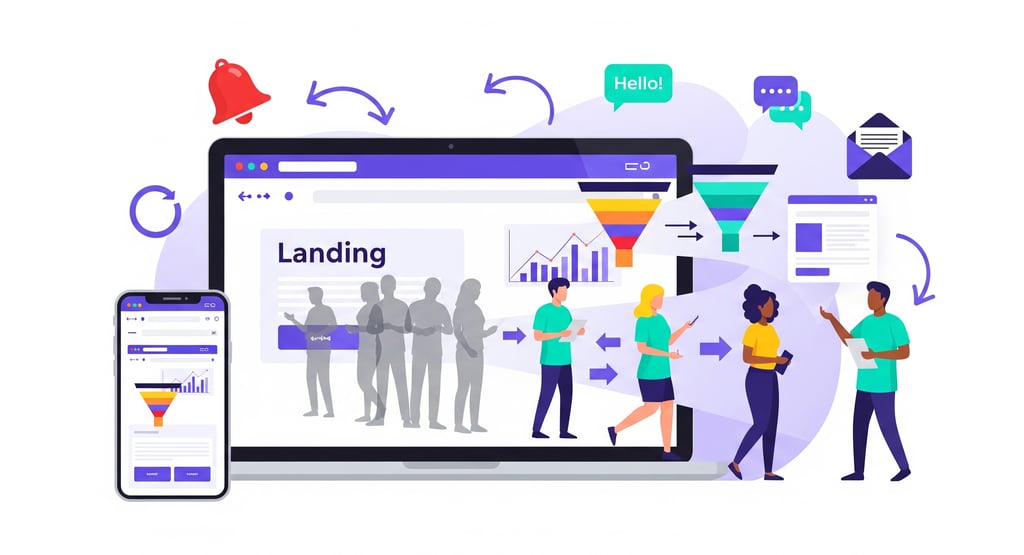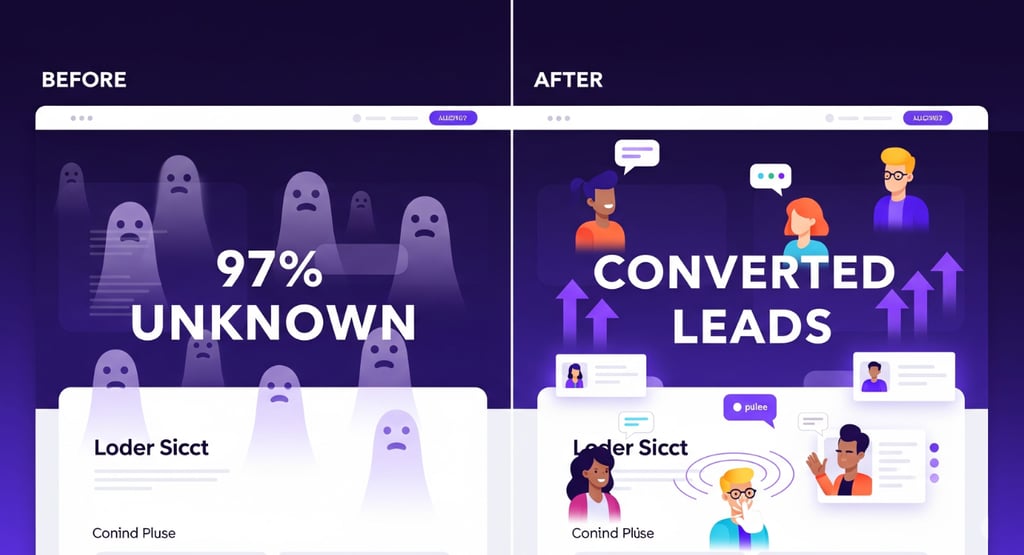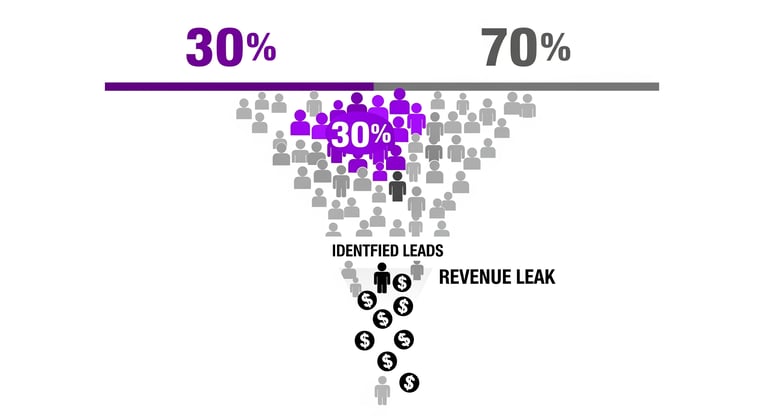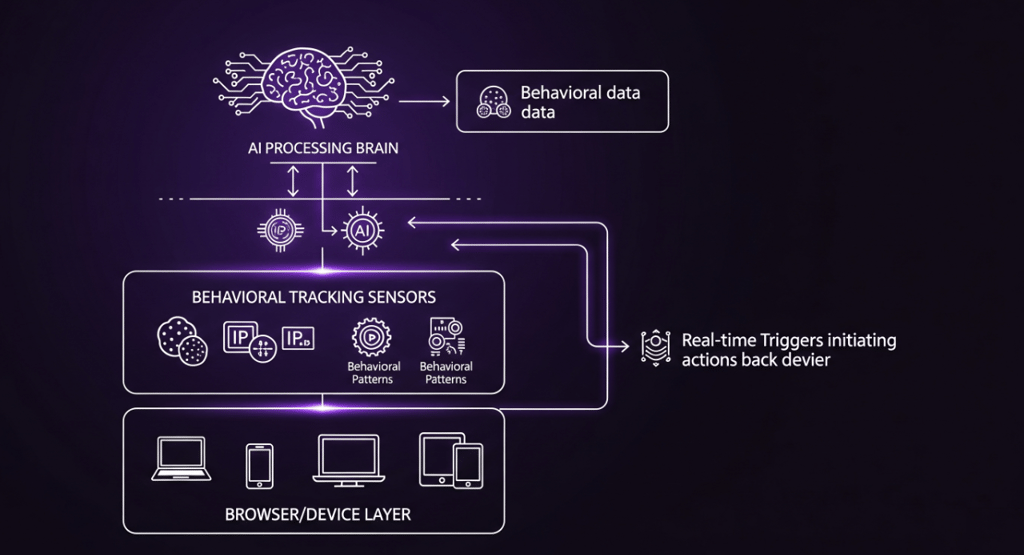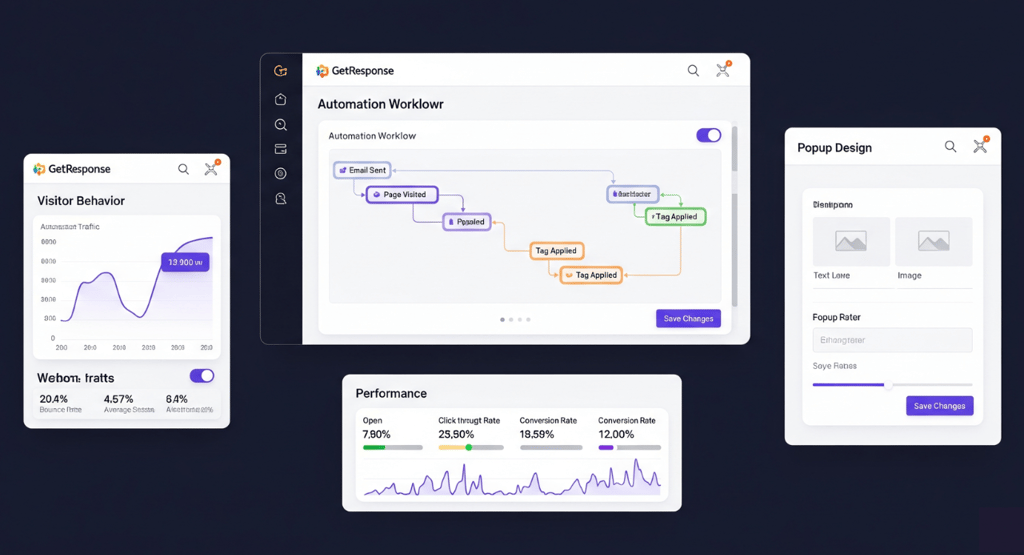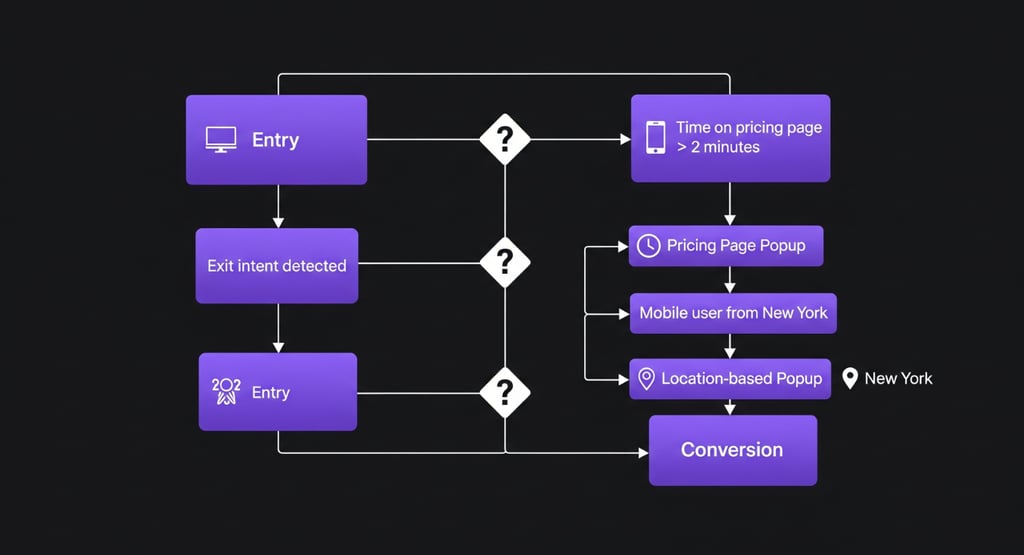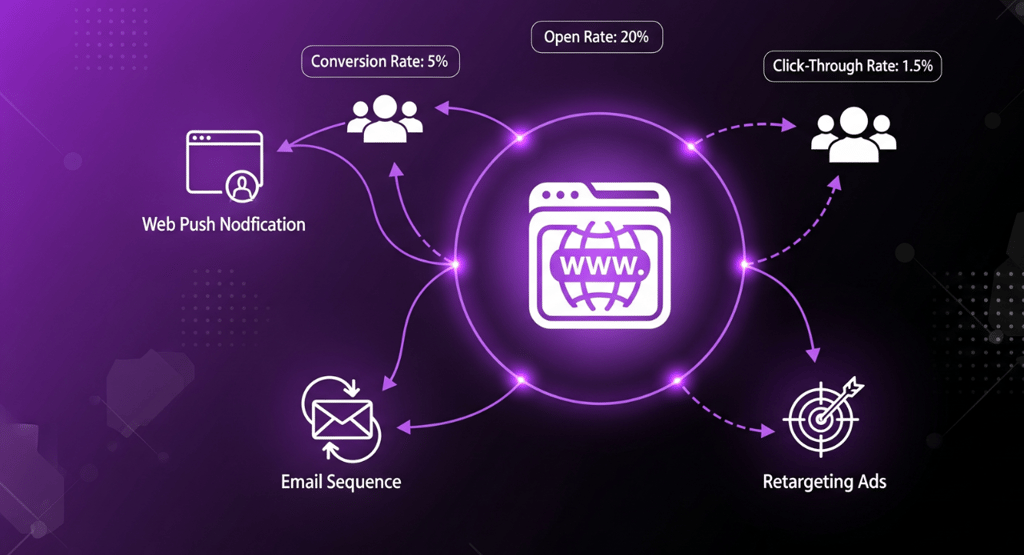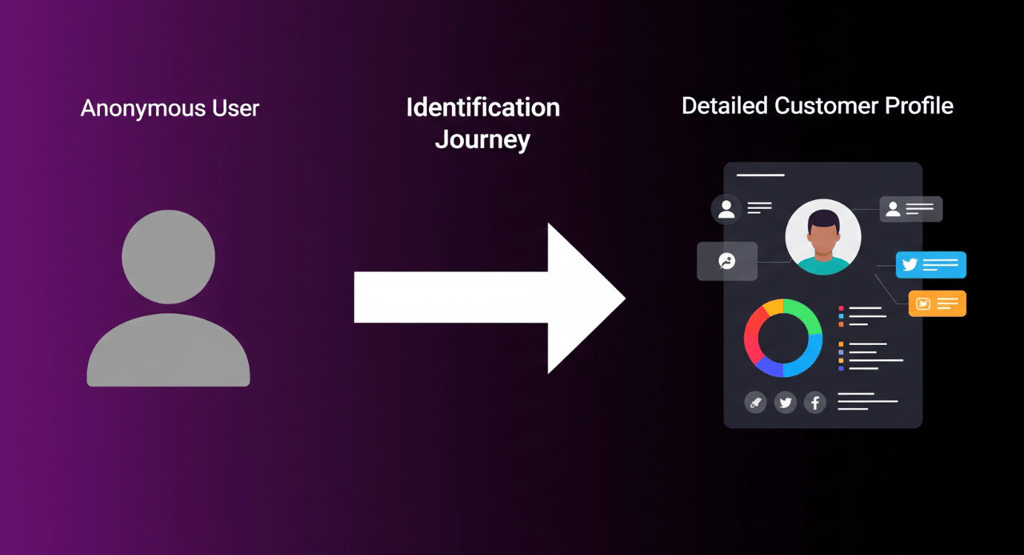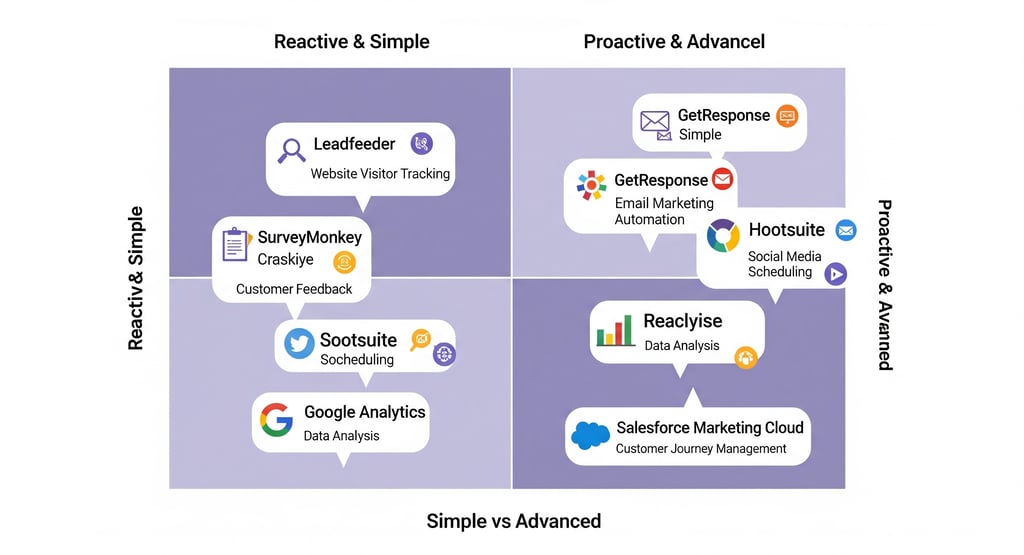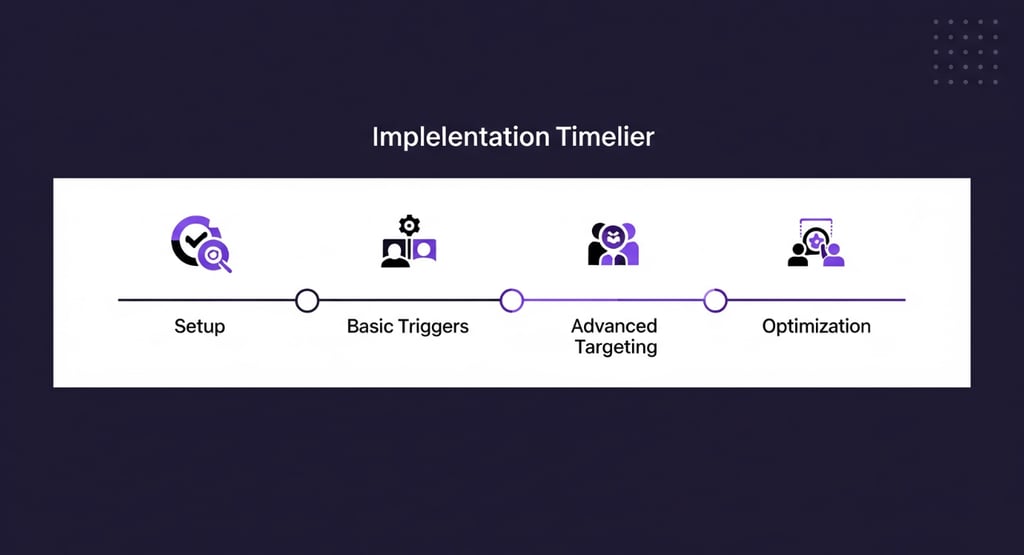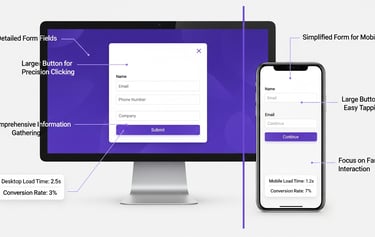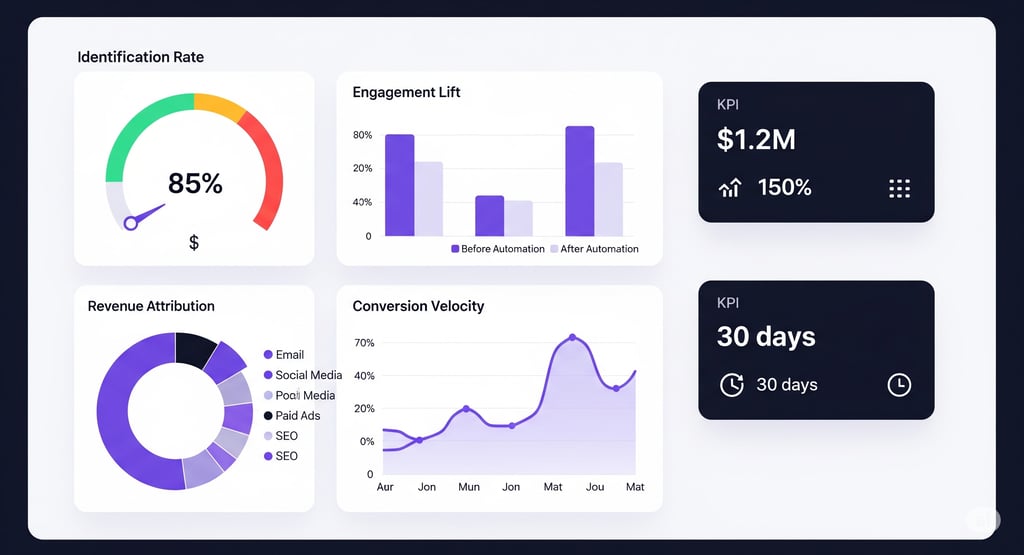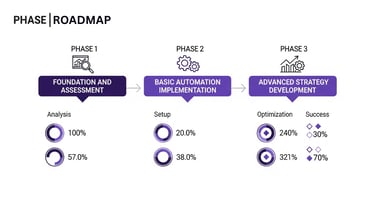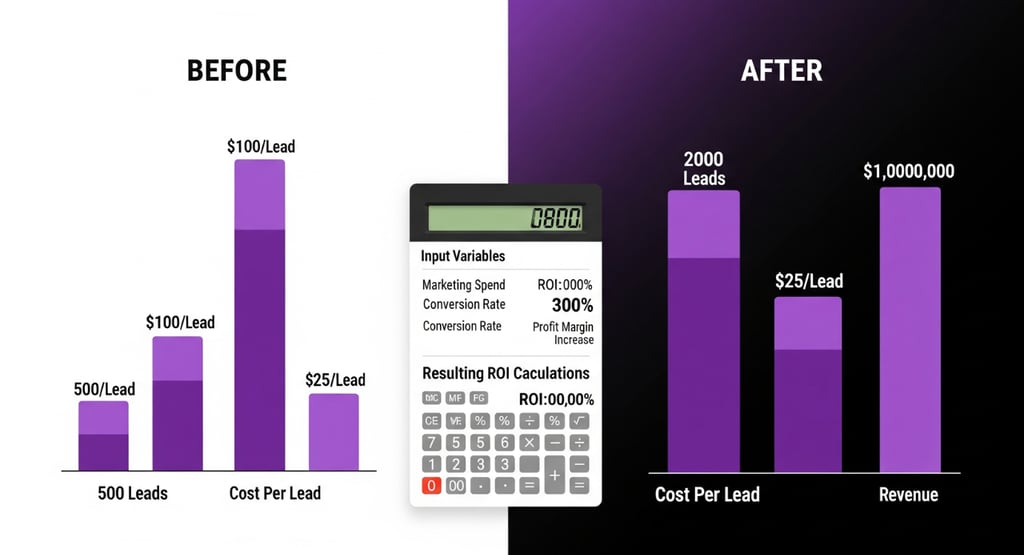Beyond Email: How Web Automation Captures Revenue from Anonymous Visitors
Most businesses lose 97% of website visitors who browse anonymously. Web automation changes this by engaging unknown visitors through behavioral triggers, personalized popups, and smart messaging that converts browsers into customers without requiring email signup first.
Eddy Enoma
8/15/202514 min read
How web automation turns 97% of your invisible website visitors into paying customers
Here's a shocking fact that every business owner needs to know: up to 97% of people who visit your website leave without doing anything you can track. They look around, think about buying, and consider your products, but they're like ghosts on your website. You can't see who they are, and their potential to become customers just disappears. Regular email marketing has been the go-to method for reaching customers online, but it has one big problem: it only works with people who have already given you their email address.
This is where web automation becomes a game-changer. It goes way beyond regular email marketing to help you make money from the huge number of visitors who would normally stay unknown forever. By using smart triggers based on how people behave on your site, personalized messages, and automated workflows, businesses can now connect with unknown visitors from the moment they click on your site. This turns people who are just browsing into real prospects and, eventually, paying customers.
The Unknown Visitor Problem: Understanding Where You're Losing Money
How Big Is This Problem?
The numbers are pretty scary. Research shows that [only up to 30% of website visitors can be identified by advanced visitor tracking tools, leaving 70% completely unknown. For most businesses, this is like having a massive leak in their money bucket. Imagine if 70% of people who walked into your physical store were invisible to your sales team, that's what's happening online.
This problem gets even worse when we look at how people actually convert. Traditional ways of capturing leads face huge dropout rates: up to 67% of visitors will leave a contact form if it gets complicated, and up to 80% will leave if you ask for their email address too early. These numbers show there's a big mismatch between how businesses want to capture leads and how visitors actually want to interact.
What Unknown Visitors Cost You
Every unknown visitor is a missed chance to make money. Think about how people actually buy things: a potential customer might visit your website several times, research your products, compare prices, and even add items to their shopping cart, all while your marketing systems have no idea who they are. When they finally decide to buy something, they might choose a competitor who managed to grab their attention at the right time.
The money impact is huge. With conversion rates changing a lot based on how people find you, email and referral traffic converting at about 5% compared to 2% from Google searches and 1% from social media, businesses that can identify and connect with unknown visitors early have a big advantage over their competition.
Beyond Email: How Web Automation Has Evolved
Changing How We Think About Marketing Automation
Traditional marketing automation works on a simple idea: once someone gives you their email address, you can use detailed workflows to guide them toward buying. However this approach ignores the critical time before they give you their email, which is when most buying decisions are actually influenced.
Web automation represents a big shift, allowing businesses to engage with users from their very first visit, even before they subscribe to an email list. This "before identification" approach recognizes that valuable engagement can and should start immediately, not after someone has already decided to share their contact information.
The Technology That Makes Anonymous Engagement Work
Modern web automation platforms use several advanced technologies to identify and engage unknown visitors:
Behavioral Tracking and Analysis: Advanced systems watch visitor behavior in real-time, tracking page views, time spent on specific sections, how far they scroll, click patterns, and navigation paths. This behavioral data creates a detailed profile of what visitors want, even without knowing who they are.
IP Intelligence: While not providing personal identification, IP tracking can reveal valuable information about where visitors are located, what company they work for (for business-to-business contexts), and previous visit patterns, allowing for more targeted engagement strategies.
Device and Session Fingerprinting: By analyzing browser characteristics, screen resolution, time zone, and other technical details, systems can recognize returning visitors even without cookies, allowing for consistent engagement strategies.
Real-time Trigger Systems: These platforms can instantly respond to specific visitor actions (such as spending a lot of time on a pricing page or trying to leave the site) with targeted messages designed to capture attention and encourage identification.
GetResponse Web Automation: Turning Unknown Traffic into Revenue
The GetResponse Approach to Anonymous Visitor Conversion
GetResponse has built a comprehensive web automation platform specifically designed to solve the unknown visitor challenge. Their system recognizes that traditional marketing automation often only works after a user becomes a subscriber, missing the vast majority of website visitors who remain anonymous.
The platform's philosophy focuses on getting maximum value from existing traffic by engaging visitors before they decide to subscribe or leave. This approach acknowledges that every visitor represents potential revenue, whether or not they've provided contact information.
Main Features for Anonymous Visitor Engagement
Behavior-Triggered Popup Systems: GetResponse's personalized popups can be triggered based on visitor behavior, such as spending time on a pricing page or viewing specific products and categories. These aren't annoying, generic overlays, but smart, relevant offers that appear at exactly the right moment in the visitor's journey.
The system allows for detailed customization based on multiple factors:
• Geographic Targeting: Popups can show location-specific offers, such as local shipping information or regional promotions
• Device Optimization: Different messages and formats for mobile versus desktop visitors
• Behavioral Context: Offers tailored to the specific pages or products the visitor has been viewing
• Return Visitor Recognition: Different messaging for first-time versus returning visitors, even if they remain anonymous
Web Push Notification Integration: Web push notifications enable engagement with repeat visitors through relevant content or offers, even if they haven't provided an email address. This creates a direct communication channel that doesn't need email capture while still allowing for personalized messaging.
Push notifications can be triggered by:
• Return visits after a specific period
• Visits to high-intent pages (pricing, product comparisons)
• Leaving key conversion pages
• Time-based sequences for nurturing anonymous prospects
Advanced Workflow Automation: The platform allows marketers to create complex automation workflows that respond to anonymous visitor behavior. These workflows can include multiple touchpoints and conditional logic, creating sophisticated engagement sequences that adapt based on how visitors interact with each element.
Web Push Notification Integration: Web push notifications enable engagement with repeat visitors through relevant content or offers, even if they haven't provided an email address. This creates a direct communication channel that doesn't need email capture while still allowing for personalized messaging.
Push notifications can be triggered by:
• Return visits after a specific period
• Visits to high-intent pages (pricing, product comparisons)
• Leaving key conversion pages
• Time-based sequences for nurturing anonymous prospects
Advanced Workflow Automation: The platform allows marketers to create complex automation workflows that respond to anonymous visitor behavior. These workflows can include multiple touchpoints and conditional logic, creating sophisticated engagement sequences that adapt based on how visitors interact with each element.
Value-Driven Lead Magnets: Rather than asking for emails with vague promises of "newsletters" or "updates," the system enables businesses to offer specific, valuable resources tied to the visitor's demonstrated interests. If someone spends time researching a particular product category, they might be offered a detailed buying guide or an exclusive discount relevant to that category.
Progressive Profiling: Instead of demanding complete contact information upfront, the system can gradually collect data through multiple interactions. An initial pop-up might request only an email for a discount, while later visits could gather additional information like preferences or company details.
Social Proof Integration: Popups and engagement elements can incorporate real-time social proof, such as recent purchases, current visitor counts, or limited-time offers, creating urgency and credibility that encourages identification
Competition: How GetResponse Compares to Other Tools
The Visitor Identification Tool Market
The market for anonymous visitor identification has exploded, with many platforms offering different approaches to the challenge. Tools like Leadfeeder, Albacross, Lead Forensics, and ZoomInfo focus primarily on IP address tracking and company identification, particularly useful for business-to-business contexts.
However, these tools typically work on a reactive model, identifying visitors after they've left the site and providing information for follow-up outreach. GetResponse's web automation takes a proactive approach, engaging visitors while they're still on the site and motivated to take action.
Advanced AI-Powered Solutions
Some platforms, like SiteStop by Kwanzoo, aim to identify specific individuals along with their personally identifiable information, allowing for direct sales engagement. While powerful, these approaches raise privacy concerns and may not be suitable for all businesses or geographic regions.
Other solutions, such as Knock Knock App, focus on real-time engagement with features like live video chat and AI-powered qualification. These tools excel at immediate conversion but require significant human resources to manage effectively.
GetResponse's Unique Position
GetResponse stands out by offering a balanced approach that combines:
Immediate Engagement: Like real-time tools, it engages visitors while they're on the site
Scalable Automation: Unlike human-dependent solutions, it operates automatically 24/7
Privacy-Conscious: It focuses on voluntary identification rather than aggressive data collection
Integrated Ecosystem: Once visitors are identified, they smoothly enter GetResponse's comprehensive email marketing and automation workflows
Implementation Strategies: Getting the Most from Anonymous Visitor Conversion
Creating Effective Behavioral Triggers
Success with web automation requires understanding visitor behavior and intent signals. The most effective implementations focus on identifying high-intent moments and responding with precisely targeted offers.
High-Intent Page Targeting: Visitors who spend significant time on pricing pages, product comparison sections, or detailed feature descriptions show elevated purchase intent. These moments present optimal opportunities for engagement with relevant offers or information requests.
Exit-Intent Technology: By detecting when visitors are about to leave the site (through cursor movement patterns and other behavioral signals), businesses can present last-chance offers or valuable content that might keep their attention.
Scroll-Depth Triggers: Visitors who scroll through substantial portions of key pages demonstrate genuine interest. Automation can be triggered when someone reaches specific scroll percentages, ensuring engagement occurs after they've had the opportunity to evaluate the content.
Time-Based Engagement: Different trigger timing works for different business models. Quick-decision purchases might benefit from immediate popups, while complex business-to-business sales might require longer evaluation periods before presenting identification opportunities.
Creating Compelling Value Propositions
The success of any anonymous visitor conversion strategy depends heavily on the perceived value of the exchange. 71% of consumers expect personalized experiences, making generic offers increasingly ineffective.
Contextual Relevance: Offers must directly relate to the visitor's demonstrated interests. Someone researching project management software should receive project management resources, not general business advice.
Immediate Gratification: The most effective offers provide instant value such as, downloadable guides, immediate discounts, or instant access to exclusive content. Promises of future newsletters or updates rarely motivate anonymous visitors to identify themselves.
Exclusive Access: Creating a sense of exclusivity can significantly increase conversion rates. Limited-time offers, member-only content, or early access to new products can motivate identification when generic offers fail.
Problem-Solution Alignment: The strongest value propositions directly address specific problems the visitor is trying to solve, positioning the business as a helpful resource rather than just another vendor.
Optimizing for Mobile Experience
With mobile traffic making up an increasingly large percentage of web visits, mobile optimization is crucial for anonymous visitor conversion. Mobile users face unique challenges that must be addressed in automation design.
Simplified Interaction: Mobile popups must be easy to interact with on small screens, with large, tappable buttons and minimal form fields. Complex forms that work on desktop can kill conversions on mobile.
Loading Speed Considerations: Mobile visitors are particularly sensitive to page load times. Automation elements must be optimized to load quickly without impacting overall site performance.
Context-Aware Timing: Mobile browsing behavior differs from desktop. Mobile users often browse in shorter sessions, requiring faster engagement timing, but they're also more likely to be distracted, making timing precision crucial.
Measuring Success: KPIs Beyond Email Open Rates
Redefining Conversion Metrics for Anonymous Visitors
Traditional email marketing metrics, open rates, click-through rates, and email conversions, provide limited insight into anonymous visitor automation success. A new framework of metrics is required to assess performance and optimize strategies accurately.
Identification Rate: The percentage of anonymous visitors who provide contact information through automation triggers. This fundamental metric measures the effectiveness of value propositions and timing strategies.
Engagement Lift: Comparing the behavior of visitors who interact
with automation elements versus those who don't. Key indicators include pages per session, time on site, and bounce rate improvements.
Revenue Attribution: Tracking the lifetime value of customers acquired through anonymous visitor automation versus other channels. This requires sophisticated attribution modeling but provides crucial ROI insights.
Conversion Velocity: Measuring how quickly identified visitors progress through the sales funnel compared to traditionally captured leads. Anonymous visitor automation often produces higher-intent leads due to demonstrated behavior.
Advanced Analytics and Attribution
Behavioral Cohort Analysis: Grouping anonymous visitors by their behavior patterns and tracking how different automation strategies perform for each group. High-intent visitors might respond better to immediate offers, while researchers might prefer educational content.
Multi-Touch Attribution: Understanding how anonymous visitor automation fits into broader customer journeys. Many customers interact with automation elements during early research phases but convert through other channels later.
Predictive Scoring: Using behavioral data from anonymous visitors to predict conversion likelihood, allowing for dynamic automation strategies that adapt to individual visitor profiles.
Privacy and Ethical Considerations
Balancing Engagement with Privacy
The rise of privacy regulations like GDPR and CCPA has fundamentally changed how businesses can track and engage with website visitors. Successful anonymous visitor automation must balance effectiveness with compliance and ethical considerations.
Consent Management: Modern automation platforms must integrate with consent management systems, ensuring that tracking and engagement only occur with appropriate permissions. This can improve conversion quality by ensuring engaged visitors have explicitly opted into communication.
Transparency in Data Collection: Clear communication about what data is collected and how it's used builds trust and can actually increase willingness to engage with automation elements. Privacy-conscious visitors may be more likely to identify themselves when they understand and control the process.
Data Minimization: Collecting only necessary data reduces privacy concerns and compliance risks while often improving user experience. Sophisticated automation can be highly effective with minimal data collection.
Building Trust Through Value
The most successful anonymous visitor automation strategies focus on providing genuine value rather than trying to extract maximum information. This approach not only improves compliance but often generates higher-quality leads and better long-term customer relationships.
Educational First Approach: Positioning automation as educational and helpful rather than sales-focused builds trust and encourages engagement. Visitors are more likely to identify themselves to access genuinely useful resources.
Gradual Relationship Building: Rather than demanding maximum information immediately, successful strategies build relationships progressively, earning trust and data over time through continued value delivery.
Future Trends: The Evolution of Anonymous Visitor Engagement
Artificial Intelligence and Machine Learning
The increasing importance of AI in conversion rate optimization is transforming how businesses approach anonymous visitor engagement. Advanced AI systems can analyze vast amounts of behavioral data to predict optimal engagement timing, messaging, and offers for individual visitors.
Predictive Behavioral Modeling: AI systems can identify patterns in anonymous visitor behavior that correlate with high conversion probability, enabling more precise targeting and timing of automation triggers.
Dynamic Content Optimization: Machine learning algorithms can automatically test and optimize automation elements in real-time, continuously improving performance without manual intervention.
Intent Prediction: Advanced AI can analyze multiple behavioral signals to predict visitor intent with increasing accuracy, enabling more sophisticated and effective automation strategies.
Integration with Emerging Technologies
Voice and Conversational Interfaces: As voice search and conversational AI become more common, automation strategies will need to adapt to include voice-activated engagement and natural language interaction.
Augmented Reality Integration: For businesses selling physical products, AR integration can provide immersive experiences that encourage identification and engagement with anonymous visitors.
Real-Time Personalization: Advanced platforms will increasingly offer real-time website personalization based on anonymous visitor behavior, creating unique experiences for each visitor without requiring identification.
Implementation Roadmap: Getting Started with Anonymous Visitor Automation
Phase 1: Foundation and Assessment
Current State Analysis: Begin by understanding your current anonymous visitor challenge. Analyze website traffic patterns, identify high-value pages, and assess current conversion rates from different traffic sources.
Tool Selection and Setup: GetResponse's web automation platform provides a comprehensive starting point, but ensure proper integration with existing marketing and analytics systems for maximum effectiveness.
Baseline Measurement: Establish current metrics for visitor engagement, identification rates, and conversion performance to measure improvement accurately.
Phase 2: Basic Automation Implementation
High-Intent Page Targeting: Start with automation on your highest-value pages, pricing, product details, and comparison pages where visitor intent is clearest.
Simple Value Propositions: Start with straightforward offers like discounts or basic lead magnets to test visitor responsiveness and system functionality.
Mobile Optimization: Ensure all automation elements work effectively on mobile devices, as mobile traffic often presents the greatest conversion challenges.
Phase 3: Advanced Strategy Development
Behavioral Segmentation: Develop more sophisticated automation strategies based on visitor behavior patterns, creating different approaches for different visitor types.
Multi-Channel Integration: Expand beyond basic popups to include web push notifications, dynamic content, and integrated email workflows for identified visitors.
Continuous Optimization: Implement regular testing and optimization of automation elements, ultilizing data-driven insights to improve performance continuously.
ROI and Business Impact
Quantifying the Anonymous Visitor Opportunity
The revenue impact of effective anonymous visitor automation can be substantial. Consider a typical scenario: an e-commerce business with 10,000 monthly visitors and a 2% conversion rate generates 200 conversions monthly. If anonymous visitor automation can identify an additional 5% of visitors and convert them at even half the rate of organic conversions, this represents a 50% increase in lead generation from existing traffic.
Case Study Results: While specific case studies vary by industry and implementation quality, businesses typically see:
• 15-30% increase in overall lead generation
• 20-40% improvement in cost per lead (by maximizing existing traffic)
• 10-25% reduction in customer acquisition costs
• Improved lead quality due to behavioral qualification
Long-Term Strategic Value
Beyond immediate conversion improvements, anonymous visitor automation provides strategic advantages that compound over time:
Competitive Differentiation: Businesses that effectively capture anonymous visitors gain access to prospects that competitors are missing, creating sustainable competitive advantages.
Data Asset Building: Each converted anonymous visitor adds to the business's data assets, improving future marketing effectiveness and customer understanding.
Market Intelligence: Anonymous visitor behavior provides valuable insights into market demand, product interest, and competitive positioning.
Conclusion: Embracing the Post-Email Marketing Era
The digital marketing landscape is evolving beyond the limitations of traditional email-first strategies. While email marketing remains crucial for nurturing known prospects, the real competitive advantage lies in capturing value from the vast majority of visitors who never make it into traditional marketing funnels.
GetResponse's web automation platform represents a significant step forward in this evolution, providing businesses with sophisticated tools to engage, identify, and convert anonymous visitors. By leveraging behavioral triggers, personalized engagement, and intelligent automation workflows, businesses can transform their websites from passive brochures into active revenue-generation engines.
Start your free GetResponse trial today and see how web automation can transform your anonymous visitors into paying customers.
The statistics are clear: up to 97% of website visitors remain anonymous, representing enormous untapped potential for businesses that can effectively engage this audience. As privacy regulations continue to evolve and consumer expectations for personalized experiences increase, the businesses that master anonymous visitor automation will gain sustainable competitive advantages in their markets.
The future of digital marketing isn't about replacing email, it's about expanding beyond its limitations to capture revenue from every visitor, regardless of their willingness to immediately identify themselves. In this new paradigm, web automation serves as the bridge between anonymous interest and identified opportunity, turning every website visit into a potential revenue-generating interaction.
For businesses ready to move beyond traditional email marketing limitations, the anonymous visitor automation opportunity represents not just an incremental improvement, but a fundamental transformation in how digital marketing creates value from web traffic. The question isn't whether to implement these strategies, but how quickly businesses can adapt to capture the revenue that's currently walking away anonymous.
Ready to start capturing revenue from your anonymous visitors? Get started with GetResponse's web automation platform today and transform your website into a revenue-generating machine.
Disclaimer: This article contains affiliate links to GetResponse. If you sign up through our links, we may earn a commission at no additional cost to you. We only recommend tools we genuinely believe can help your business grow
Get the latest web automation strategies sent straight to your inbox. Sign up for our newsletter below.
Subscribe for Exclusive Tips & Updates. Enter Your Email Below!



Get the latest strategies on content creation, freelancing, and affiliate marketing, plus passive income straight to your inbox!
🔒 We respect your privacy. Your email is safe with us. Unsubscribe anytime.
Address
Sporerweg 16
94234 Viechtach, Germany
Contacts Us
(049) 170 499 6273
Subscribe to our newsletter
© 2026 Onlinebizoffers. All rights reserved.

